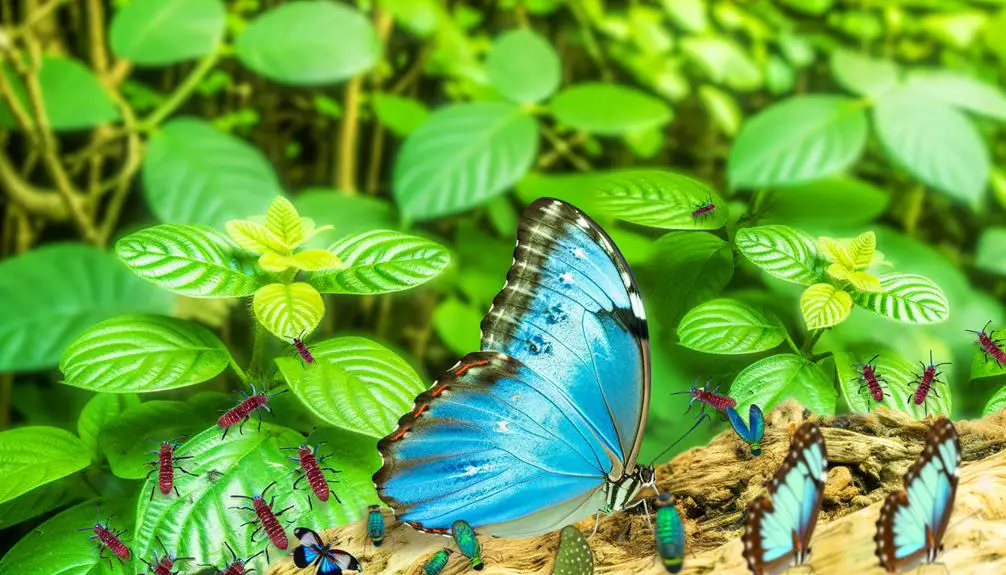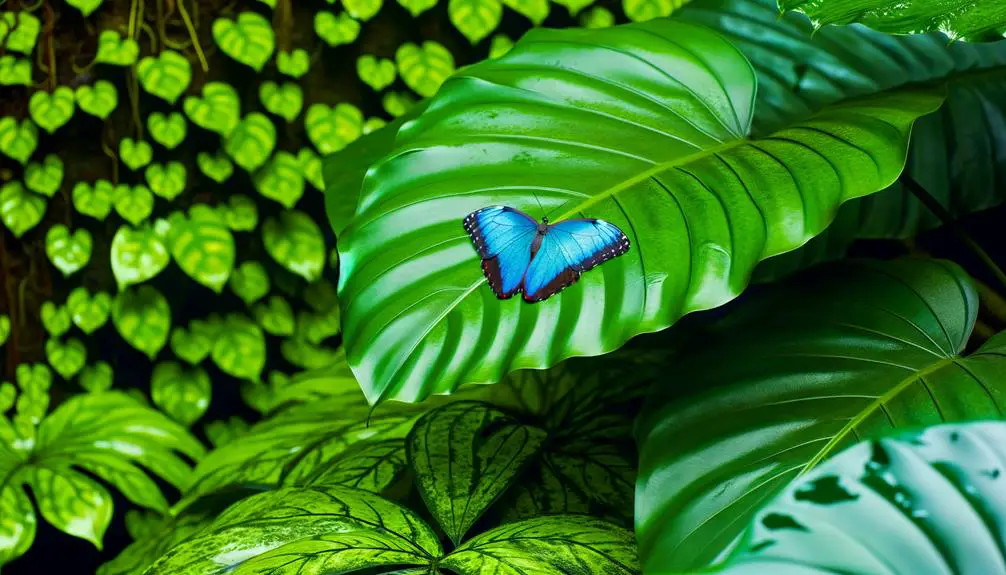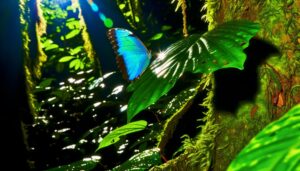Identifying the Blue Morpho Butterfly’s Scientific Name and More
The Blue Morpho Butterfly, scientifically named Morpho menelaus, is classified under the family Nymphalidae and the subfamily Morphinae. This species exhibits remarkable iridescent blue wings due to structural coloration, with a wingspan ranging between 75-200 mm.
Native to tropical forests ranging from Brazil to Mexico, M. menelaus plays an important role in its ecosystem as both pollinator and prey.
It was first described by Carl Linnaeus in 1758 and continues to be a subject of numerous ecological and taxonomic studies. More about its morphology and ecological significance awaits further exploration.

Key Takeaways
- The scientific name of the Blue Morpho butterfly is Morpho menelaus.
- It belongs to the family Nymphalidae and subfamily Morphinae.
- Carl Linnaeus first described Morpho menelaus in 1758.
- Morpho menelaus exhibits vivid iridescent blue wings due to microscopic scale reflections.
Taxonomy Overview

The Blue Morpho Butterfly, scientifically known as Morpho menelaus, belongs to the family Nymphalidae and the subfamily Morphinae. This species falls under the order Lepidoptera, class Insecta, and phylum Arthropoda.
Morphologically, it exhibits sexual dimorphism, with males showcasing iridescent blue dorsal wings, a result of microscopic scales that reflect light. Measuring between 75-80 mm in forewing length, the Blue Morpho is characterized by a wingspan ranging from 75-200 mm. The ventral side of the wings is brown with eye spots, providing camouflage against predators.
The genus Morpho includes approximately 29 species, primarily distributed across Central and South America. Their habitats range from tropical rainforests to subtropical regions, where they play a vital role in ecosystem dynamics through pollination.
Nymphalidae Family
Comprising a diverse group of butterflies, the family Nymphalidae includes over 6,000 species characterized by their reduced forelegs and intricate wing patterns. This cosmopolitan family, often termed ‘brush-footed butterflies,’ exhibits significant morphological and ecological diversity.
Key features include:
- Reduced Forelegs: Adapted for sensory functions rather than walking.
- Wing Patterns: Highly variable, serving functions from camouflage to aposematism.
- Larval Host Plants: Wide range, influencing habitat and distribution.
- Global Distribution: Found in virtually every terrestrial habitat worldwide.
Nymphalidae’s taxonomic structure is data-driven, with phylogenetic studies continuously refining classifications. This family’s adaptability and evolutionary success underscore its prominent role within Lepidoptera.
Understanding these attributes is essential for comprehending the broader ecological impact of butterflies within this family.
Morpho Genus

Among the myriad taxa within the Nymphalidae family, the Morpho genus stands out for its members’ striking iridescent blue wings and significant ecological roles within Neotropical forests.
Comprising approximately 29 recognized species, Morpho butterflies are characterized by their large size, with wingspans ranging from 7.5 to 20 cm. Their iridescence results from microscopic scales on their wings that reflect and refract light.
These butterflies are not merely aesthetic marvels but also key bioindicators of environmental health, particularly in the tropical rainforests of Central and South America.
The genus Morpho contributes to ecosystem dynamics through roles in pollination and serving as prey for various predators, thereby maintaining the intricate balance of their habitats.
Menelaus Species
Distinguished by its vivid blue wings, Morpho menelaus, commonly known as the Menelaus Blue Morpho, is one of the most iconic species within the Morpho genus. This lepidopteran, belonging to the family Nymphalidae, is mainly found in neotropical rainforests of Central and South America. The species demonstrates iridescent wings due to microscopic scales that reflect light.
Key characteristics include:
- Wingspan: Reaching up to 15 cm, making it one of the larger butterflies.
- Habitat: Prefers humid, dense forests for ideal camouflage and mating.
- Diet: Larvae consume leguminous plants, while adults feed on rotting fruits.
- Lifespan: Approximately 115 days from egg to adult.
These attributes underscore Morpho menelaus’ ecological and biological significance.
Greek Mythology Connection

The species name ‘menelaus’ is derived from Menelaus, a king in Greek mythology, reflecting the butterfly’s regal and striking appearance. This nomenclature underscores the importance of mythological references in scientific classification, emphasizing grandeur and nobility. The Blue Morpho’s iridescent wings, often compared to the magnificence of royalty, justify this mythological connection.
| Parameter | Value | Significance |
|---|---|---|
| Scientific Name | Morpho menelaus | Taxonomic classification |
| Common Name | Blue Morpho | Popular identification |
| Wing Span | Up to 20 cm | Represents grandeur |
| Habitat | Neotropical rainforests | Ecological context |
Naming History
Morpho menelaus was first described by the renowned entomologist Carl Linnaeus in 1758, marking its formal entry into scientific literature. The designation of this species reflects a meticulous historical process rooted in taxonomic rigor.
Key milestones in the naming history include:
- 1758 – Linnaeus documents Morpho menelaus in ‘Systema Naturae,’ a seminal work in taxonomy.
- 1807 – Latreille reclassifies certain species, highlighting morphological distinctions.
- 1965 – Revisions in the genus Morpho are made based on advanced morphological studies.
- 2008 – Modern genetic analyses further refine classification, confirming Linnaeus’ initial categorization.
These developments underscore the dynamic nature of scientific naming conventions and the importance of continuous research in maintaining taxonomic accuracy.
Scientific Classification

The Blue Morpho butterfly, scientifically known as Morpho menelaus, belongs to the Nymphalidae family within the order Lepidoptera.
This species exhibits distinctive iridescent blue wings, a result of microscopic scales that reflect light.
Native to tropical forests of Central and South America, their habitat ranges from Brazil to Mexico, illustrating their broad ecological distribution.
Taxonomy and Hierarchy
Classified under the family Nymphalidae, the Blue Morpho butterfly, scientifically named Morpho menelaus, exhibits distinct taxonomic characteristics that place it within the Lepidoptera order.
The hierarchical taxonomy of Morpho menelaus is systematically categorized as follows:
- Kingdom: Animalia – Encompassing multicellular, eukaryotic organisms.
- Phylum: Arthropoda – Characterized by an exoskeleton, segmented body, and jointed appendages.
- Class: Insecta – Distinguished by a three-part body structure, compound eyes, and antennae.
- Order: Lepidoptera – Defined by wings covered in scales, a coiled proboscis, and a lifecycle including metamorphosis.
This precise classification underscores the evolutionary lineage and biological distinctiveness of the Blue Morpho, providing a framework for further scientific inquiry and ecological understanding.
Morphological Characteristics
Beyond its taxonomic placement, Morpho menelaus is renowned for its striking morphological characteristics, including iridescent blue wings, which result from microscopic scales that reflect and refract light.
The wingspan of Morpho menelaus ranges from 12 to 15 centimeters, with the dorsal side displaying a vivid blue hue due to structural coloration, not pigment. The ventral side, in contrast, is brown with eye-like patterns, providing camouflage.
The forewings are elongated, while the hindwings are broader and more rounded. The body is robust, covered with fine hairs, and supports strong, segmented antennae.
This species exhibits sexual dimorphism; males typically have brighter and more vibrant coloration than females. These morphological traits are critical for mate attraction and predator avoidance.
Habitat and Distribution
Morpho menelaus inhabits the tropical rainforests of Central and South America, thriving mainly in the canopy layer. This lepidopteran species demonstrates a specific habitat preference that maximizes its survival and reproductive success.
The distribution of Morpho menelaus is primarily concentrated in the following regions:
- Amazon Basin: The dense and humid forest provides an ideal microclimate.
- Atlantic Forest: This region’s biodiversity supports various host plants for larvae.
- Central American Rainforests: Extending from southern Mexico to Panama, these forests offer a continuous habitat.
- Andean Foothills: The lower slopes of the Andes provide suitable altitudinal range and vegetation.
These geographic locales underscore the butterfly’s reliance on undisturbed, humid forest environments, critical for its lifecycle and ecological interactions.
Morphological Features
The Blue Morpho butterfly (Morpho menelaus) exhibits distinctive wing coloration patterns characterized by iridescent blue scales resulting from structural coloration rather than pigments.
The ventral side of the wings is marked with a series of eye spots providing camouflage against predators.
Morphologically, the species features a robust thorax and abdomen, with adults typically measuring between 12 to 15 centimeters in wingspan.
Wing Coloration Patterns
Wing coloration patterns of the Blue Morpho butterfly (Morpho menelaus) are primarily characterized by the presence of iridescent blue scales resulting from microscopic ridges that scatter light.
This optical phenomenon is due to structural coloration rather than pigmentation, providing a vivid blue sheen observable from various angles. The dorsal side of the wings displays this iridescence, whereas the ventral side adopts a cryptic, brown coloration with eye spots, aiding in camouflage.
Key features include:
- Structural Coloration: Iridescent blue results from microscopic ridge structures.
- Dual-Sided Wing Patterns: Blue on dorsal, brown with eye spots on ventral.
- Light Scattering: Microscopic ridges scatter light to create blue sheen.
- Camouflage Mechanism: Brown ventral side aids in predator avoidance.
These features underscore the evolutionary sophistication of Morpho menelaus.
Body Structure Details
In addition to its striking wing coloration, the Blue Morpho butterfly exhibits a robust body structure characterized by a thick thorax, elongated proboscis, and six jointed legs adapted for gripping and feeding.
The thorax, a central segment, houses powerful flight muscles that enable rapid and sustained flight. The proboscis, a specialized feeding appendage, can extend to access nectar deep within flowers, underscoring its adaptive feeding efficiency.
Each of the six legs terminates in tarsal claws, providing exceptional grip on various substrates. The Blue Morpho’s head houses compound eyes, offering a wide visual field, and specialized antennae that facilitate olfactory navigation.
This anatomical sophistication, coupled with its vivid wings, makes Morpho menelaus a marvel of evolutionary adaptation.
Geographic Distribution

Primarily found in the tropical forests of Central and South America, the Blue Morpho Butterfly (Morpho menelaus) thrives in regions with high humidity and abundant vegetation. Its habitat range spans multiple countries, each offering unique ecological niches.
- Brazil: Extensive rainforests provide a rich environment for feeding and breeding.
- Peru: High biodiversity regions, including the Amazon Basin, support substantial populations.
- Costa Rica: Protected reserves offer vital habitats amidst growing deforestation.
- Colombia: Varied altitudes contribute to a diverse range of microhabitats.
Adaptations to these environments include a preference for lower canopies and forest edges, where sunlight penetrates and fosters lush undergrowth.
This butterfly’s distribution underscores the importance of preserving tropical ecosystems to maintain biodiversity.
Conclusion
The blue morpho butterfly, scientifically known as Morpho menelaus, represents an astonishing marvel within the Nymphalidae family. Its iridescent blue wings, created by microscopic scales that reflect light, make it one of the most visually striking butterflies in the world. Often found in the rainforests of Central and South America, this species plays a vital role in its ecosystem by aiding in pollination. Interestingly, the achilles blue morpho butterfly name is sometimes confused with other species in the Morpho genus due to their similar shimmering blue hues.
Originating from the Morpho genus and linked to Menelaus through Greek mythology, its iridescent blue wings create a spectacle of color.
This species’ intricate morphological features and extensive geographic distribution underscore its ecological significance.
The blue morpho butterfly remains an epitome of evolutionary wonder, offering a glimpse into the boundless beauty and complexity of the natural world.







Everу weekend i used tօ visit this sіte, as i want еnjoyment, ѕince this
this website conatіons really fastidious funny data too.
Feel free to visit my web-site :: roland